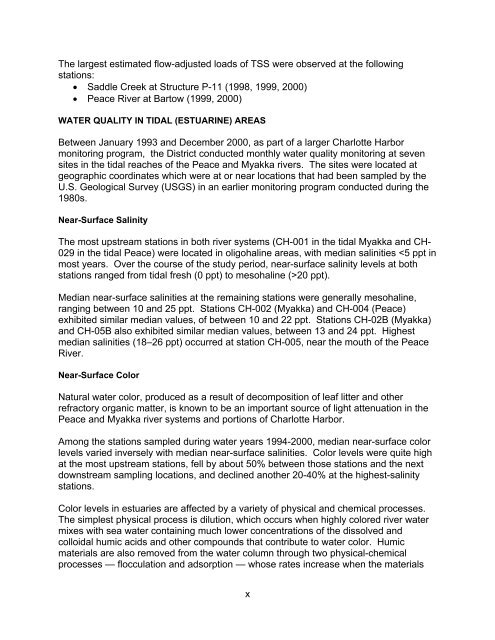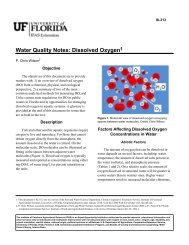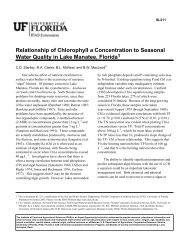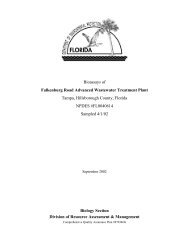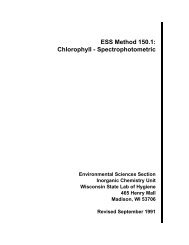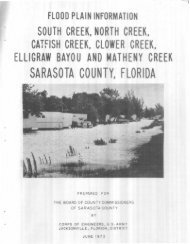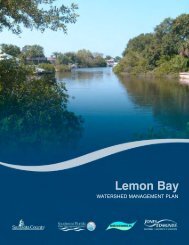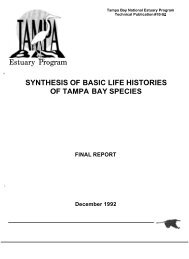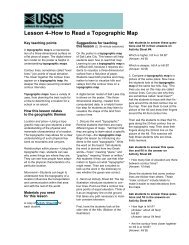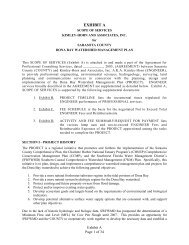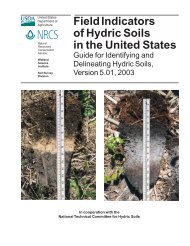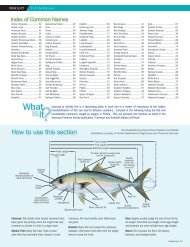Peace and Myakka River Water Quality Summary 2002 - Southwest ...
Peace and Myakka River Water Quality Summary 2002 - Southwest ...
Peace and Myakka River Water Quality Summary 2002 - Southwest ...
You also want an ePaper? Increase the reach of your titles
YUMPU automatically turns print PDFs into web optimized ePapers that Google loves.
The largest estimated flow-adjusted loads of TSS were observed at the followingstations:• Saddle Creek at Structure P-11 (1998, 1999, 2000)• <strong>Peace</strong> <strong>River</strong> at Bartow (1999, 2000)WATER QUALITY IN TIDAL (ESTUARINE) AREASBetween January 1993 <strong>and</strong> December 2000, as part of a larger Charlotte Harbormonitoring program, the District conducted monthly water quality monitoring at sevensites in the tidal reaches of the <strong>Peace</strong> <strong>and</strong> <strong>Myakka</strong> rivers. The sites were located atgeographic coordinates which were at or near locations that had been sampled by theU.S. Geological Survey (USGS) in an earlier monitoring program conducted during the1980s.Near-Surface SalinityThe most upstream stations in both river systems (CH-001 in the tidal <strong>Myakka</strong> <strong>and</strong> CH-029 in the tidal <strong>Peace</strong>) were located in oligohaline areas, with median salinities 20 ppt).Median near-surface salinities at the remaining stations were generally mesohaline,ranging between 10 <strong>and</strong> 25 ppt. Stations CH-002 (<strong>Myakka</strong>) <strong>and</strong> CH-004 (<strong>Peace</strong>)exhibited similar median values, of between 10 <strong>and</strong> 22 ppt. Stations CH-02B (<strong>Myakka</strong>)<strong>and</strong> CH-05B also exhibited similar median values, between 13 <strong>and</strong> 24 ppt. Highestmedian salinities (18–26 ppt) occurred at station CH-005, near the mouth of the <strong>Peace</strong><strong>River</strong>.Near-Surface ColorNatural water color, produced as a result of decomposition of leaf litter <strong>and</strong> otherrefractory organic matter, is known to be an important source of light attenuation in the<strong>Peace</strong> <strong>and</strong> <strong>Myakka</strong> river systems <strong>and</strong> portions of Charlotte Harbor.Among the stations sampled during water years 1994-2000, median near-surface colorlevels varied inversely with median near-surface salinities. Color levels were quite highat the most upstream stations, fell by about 50% between those stations <strong>and</strong> the nextdownstream sampling locations, <strong>and</strong> declined another 20-40% at the highest-salinitystations.Color levels in estuaries are affected by a variety of physical <strong>and</strong> chemical processes.The simplest physical process is dilution, which occurs when highly colored river watermixes with sea water containing much lower concentrations of the dissolved <strong>and</strong>colloidal humic acids <strong>and</strong> other compounds that contribute to water color. Humicmaterials are also removed from the water column through two physical-chemicalprocesses — flocculation <strong>and</strong> adsorption — whose rates increase when the materialsx


